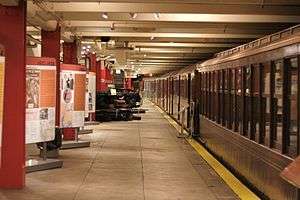New York Transit Museum
 Side view of the street entrance on the corner of Boerum Place and Schermerhorn Street | |
 Location in New York City | |
| Established | July 4, 1976 |
|---|---|
| Location |
Former Court Street station, Boerum Pl., Brooklyn, NY 11201 United States |
| Coordinates | 40°41′25″N 73°59′24″W / 40.6904°N 73.9900°WCoordinates: 40°41′25″N 73°59′24″W / 40.6904°N 73.9900°W |
| Type | Railway and mass transit museum |
| Accreditation | ASTC |
| Public transit access |
Bus: B25, B26, B38, B41, B45, B52, B57, B61, B62, B63, B65, B103 Subway: Court Street – Borough Hall Jay Street – MetroTech |
| Website | www.nytransitmuseum.org |
The New York Transit Museum (also called the NYC Transit Museum) is a museum that displays historical artifacts of the New York City Subway, bus, commuter rail, and bridge and tunnel systems under the administration of the Metropolitan Transportation Authority (MTA). The main Museum is located in the decommissioned Court Street subway station in Downtown Brooklyn and Brooklyn Heights in the New York City borough of Brooklyn. There is a smaller satellite Museum Annex in Grand Central Terminal in the midtown area of Manhattan.
Historic use as station
| Court Street | |||
|---|---|---|---|
| Former New York City Subway rapid transit station | |||
|
Station platform with museum exhibits | |||
| Station statistics | |||
| Address |
Schermerhorn Street & Boerum Place Brooklyn, NY 11201 | ||
| Borough | Brooklyn | ||
| Locale | Downtown Brooklyn | ||
| Coordinates | 40°41′25″N 73°59′24″W / 40.6904°N 73.99°W | ||
| Line | IND Fulton Street Line | ||
| Services | None (currently occupied by museum) | ||
| Structure | Underground | ||
| Platforms | 1 island platform | ||
| Tracks | 2 | ||
| Other information | |||
| Opened | April 9, 1936 | ||
| Closed | June 1, 1946 (as a subway station) | ||
| Accessible |
| ||
| Station succession | |||
| Next north | (Terminal): no regular service | ||
| Next south | Hoyt–Schermerhorn Streets: no regular service | ||
|
| |||
| Next | none: no regular service | ||
| Next |
Franklin Avenue (local): no regular service Utica Avenue (express): no regular service | ||
| |||
The museum is located in an actual subway station, which was originally called Court Street.[1]:1 The Court Street station was built as a terminus for local trains of the IND Fulton Street Line and opened on April 9, 1936, along with a long section of the Fulton Street Line and the Rutgers Street Tunnel.[2][3] The station has one center island platform with two tracks. The tracks end at bumper blocks just beyond the west end of the platform. The station walls feature a tile band set in a course two tiles high (as is the case with most IND local stations), colored aquamarine with a cerulean blue border.[4]
The station exemplified the IND service theory and the design of most of the Manhattan trunk lines, which specified that local trains should operate within individual boroughs where possible, and provide transfers to express trains which would be through-routed between the boroughs.[5] Court Street was to be the northern terminal of the HH Fulton Street Local, which would run south (geographically east) to Euclid Avenue. Additionally, one of the alternative plans for the Second Avenue Subway would have included a southern extension to Brooklyn, tying into the stub at Court Street to accommodate through service to/from Manhattan.[6][7][8]
The HH through service was never inaugurated; the only trains to serve the station were part of the Court Street Shuttle, taking passengers from Court Street to the transfer station at Hoyt–Schermerhorn Streets.[2] Due to the proximity of other stations in the Downtown Brooklyn area, as well as the need to transfer to reach it, Court Street never saw much traffic and was abandoned on June 1, 1946.[5][9][10] However, it is still a functioning subway station; trains are moved into and out of the exhibits using the tunnel between the station platforms and the outer tracks at Hoyt–Schermerhorn Street station (see below). Following the station's closure, most of the entrances to the street were sealed.[11]
While the station was closed to the public, non-revenue trains would occasionally run to and from the station, with the purpose of "keeping the rails polished".[12] On March 15, 1960, the New York City Transit Authority tested a new cleaning process on the walls of the Court Street station, which had been stained after years without use.[13] Meanwhile, the sealed but still-present station entrances became dumping grounds for garbage.[14]
The station was also used a set for movies: three years after its closing in 1949, the station was used for the filming of the film Guilty Bystander.[15] On November 26, 1956, the station was used to film a scene of The FBI Story, posing as the Bowling Green station.[16] After the museum opened, the station continued to be used as a set for movies,[11][17] most notably the 1974 film The Taking of Pelham One Two Three,[18] and the entrance at Boerum Place and Schermerhorn Street was reopened for shoots. To this day, the station and its connecting tunnels are still used for movie shoots. The 2009 The Taking of Pelham One Two Three, a remake of the 1974 movie, was also filmed there. More recently, the Museum appeared in the Life on Mars episode "The Simple Secret of the Note In Us All", where a newspaper columnist is found murdered on a subway car. The Museum remains open to requests to use the station for filming, as well as to host private events during hours the Museum is not normally open.
- Street entrance
 Bumper block at end of Track A2
Bumper block at end of Track A2
Station layout
| G | Street Level | Exit/Entrance (stairs and elevator) |
| M | Mezzanine area | Exhibits, museum store |
| P Former platform level |
Track A2 (see list below for cars) | → No passenger service (No service: Hoyt–Schermerhorn Streets) |
| Island platform, used for exhibits | ||
| Track A1 (see list below for cars) | →No passenger service (No service: Hoyt–Schermerhorn Streets) | |
The station was a two-track, one-island platformed station while in service. An ADA-accessible chair lift and elevator were added after the station was converted into a museum.
Museum and scope
On July 4, 1976, the New York City Transit Exhibit was opened in the decommissioned underground station as part of the United States Bicentennial celebration, with one subway token for admittance. Old subway cars which had been preserved, as well as models and other exhibits were displayed.[17][19][20] Plans were to keep the museum open until September 7 of that year,[17] but it proved to be so popular that it remained open and eventually became a permanent museum. On weekends during its initial opening, museum nostalgia trains would run between 57th Street − Sixth Avenue and Rockaway Park, making an intermittent hour-long stop at the exhibit.[17][19]
The Transit Museum's main entrance is located at the corner of Boerum Place and Schermerhorn Street in downtown Brooklyn. There is a newer, separate ADA-accessible entrance for those with physical disabilities; the wheelchair lift is located at Court and Schermerhorn Streets,[21] and, unlike the elevators in most New York City stations, must be accessed by requesting it in advance or using a call button.[22]
Subway artifacts

The Museum includes subway, bus, railway, bridge, and tunnel memorabilia and other exhibits including vintage signage, models and dioramas of subway, bus and other equipment. A program of lectures, seminars, films, and tours for all ages is available at the Museum. In addition, offsite programs consist of guided tours of MTA facilities, subway stations, artwork and architecture, and New York neighborhoods, as well as opportunities to ride vintage railway and bus equipment.
The museum's mezzanine (upper) level contains the majority of the exhibits, restrooms, water fountains, a screening room, and a dining space for visitors who have brought their own food or drink. Artifacts from historic subway and bus operations, as well as NYC transportation infrastructure, are on display. The exhibits on the upper level frequently change.
On the platform (lower) level, two fully powered operational subway tracks contain many historic examples of New York City Subway and Elevated railway equipment as a permanent display. Preserved subway cars, most of which can still be run, date as far back as the predecessor companies that came before the New York City Transit Authority, such as the BMT and IRT private companies, and the city owned and operated IND. In addition to the subway cars, there is a large wheel truck and motor (bogie) on display, a refrigerator-sized plug-in circuit breaker, a complete relay-based classic electric motor controller, and numerous other artifacts that highlight topics such as subway signaling and control, electrical power, railway infrastructure, station maps and signage, and station artwork. In addition, a fully functional underground "signal tower" control room is on view, a facility that was used to monitor the IND Fulton Street Line and IND Crosstown Line when the subway station was in active revenue service.[17] The track diagram indicator lights and control levers are fully operational, and are still needed when the subway cars on display are replaced or moved; however, since the controls are live, the control panel is secured and locked, but visitors can still view it through a window and read explanatory signs.
Bus fleet and artifacts
.jpg)
Besides subway cars, the Museum has a sizable vintage bus fleet of retired buses. Because there is no area available for their permanent exhibition in the underground Museum, they are stored in various bus depots around the city. They are brought out for special events, such as the Museum's annual "Bus Festival," which is held annually in conjunction with the Atlantic Antic street fair. The Bus Festival began as an annual tradition in 1994. During the Bus Festival, the Museum opens its doors for free. Documents, photographs, and artifacts are stored both in the Museum and in the nearby Archives, adding to the goal of preserving the legacy of transportation in New York. Historians and researchers who wish to visit the Archives are able to do so through the Museum. Some images from their collection can also be seen on Historypin.[23]
The fleet includes:
- #3100 (built 1956) was the first air-conditioned bus in use in any American transportation system. An experimental bus of the Fifth Avenue Coach Company, it had rear exit doors that passengers pushed to open; seats wrapping around the back of the bus; soft seats; and fluorescent lights. It last saw passenger service in the mid-1970s, having been used later for the New York City Transit Police.[24]
- #236 (built 1980) was a high-tech bus for its age, having wheelchair-accessible lifts and electronic marquees. The fleet had many mechanical problems and was pulled from service after four years.[24]
- #2969 (originally #4789; built 1948) was custom-made for the city's transit system and was one of the first 40-foot (12 m) buses. Its front door was twice as wide as other buses' front doors at the time. It was renumbered after the bus that Jackie Gleason's character in The Honeymooners, Ralph Kramden, was pictured in.[24]
- #3865 (built 1993) was operated by Queens Surface Corporation during its first years of service, but in May 2000, the bus became under the operation of Jamaica Buses. Twelve of the former Queens Surface buses (including #3865) replaced some 1980s-era buses that Jamaica Buses operated.[24]
- #100 (built 1959) was a "New Look" bus built by GMC. In total, 190 "New Look" buses operated in New York City. Each had a curved windshield with a one-piece overhead route sign and windows shaped like parallelograms.[24]
- #621 (built 1979) was a "Fishbowl" bus built by General Motors of Canada and one of ten such buses used in New York City until the 1990s.[24]
- #3006 (built 1988) was a "Classic" bus operated by Liberty Lines Transit and used from 1982 to 2006.
- #1502 (built 1982) was a "New Look" bus. The 25 buses were operated by New York Bus Service. These buses had seats that faced forward; overhead racks and lights; and one door at the front.[24]
- #5227 (built 1971 and rebuilt 1985) was one of 350 "New Look" buses that were rebuilt in Chicago. The buses, which had hard, blue lengthwise seating, were the last NYCT buses without a wheelchair lift.[24]
- #1201 (built 1981) was one of ultimately 4,877 Rapid Transit Series buses used by the MTA Regional Bus Operations companies from 1981 to 1999. These buses all had wheelchair lifts, making MTA the first agency in the United States to have a fully accessible bus fleet.[24]
- #8928 (built 1968) was one of 133 buses that replaced an earlier, 1956 fleet. Thirteen buses were operated on Staten Island express buses and were later used as buses between John F. Kennedy International Airport and the JFK Express at Howard Beach–JFK Airport.[24]
Some bus artifacts are present in the station. A revenue bag, one of many provided for use for bus drivers with the Third Avenue Transit Corporation, was used during the 1950s to transport money out of the buses. It is part of the interactive "Show Me the Money: From the Turnstile to the Bank" exhibit, where visitors could "see an image of the vacuum that attaches to the fare box and sucks the coins out."[1]:2
Other aspects
In the mid-1990s the Metropolitan Transportation Authority (MTA) assumed control of the Transit Museum from the New York City Transit Authority. At that time, the scope of the museum was expanded to include other aspects of transportation services within the MTA region, including commuter rail (Metro-North, Staten Island Railway, Long Island Rail Road) and roads / bridges (MTA Bridges and Tunnels). Since then, rotating exhibits on the mezzanine level frequently highlight commuter railroad and bridge/tunnel operations, as well as their history.
Other artifacts in the museum include a poster for the 1926 lost film, Subway Sadie, as well as an original brass light fixture from the station's operating days.[1]:2 It also features an original mosaic plaque from he 137th Street station, dating back to the subway's 1904 opening.[1]:1
Current exhibits
As of January 2012 the Museum featured several exhibits:
- Steel Stone and Backbone, which highlights the challenges and labor involved in subway construction during the period 1900-1925.[25]
- Fare Collection, which explains different methods New Yorkers have used to pay subway fare over the years, and contains authentic subway turnstiles for passage through.[1]:1[25]
- ElectriCity: Powering New York's Rails, an interactive exhibit showing the various types of electric power generation, how it gets to the subway and how electric motors work.[26]
- Show Me the Money: From the Turnstile to the Bank, which explains the old (pre-2006) process of revenue collection in the New York City Subway via money trains and cloth "money bags."[1]:1
- On the Streets, which contains a comprehensive history of New York City's street transportation from horse pulled vehicles to modern buses, as well as two bus installations visitors can sit in, including the driver's seat.[25]
- Clearing the Air, which discusses modern street transportation and its impact on the environment, and highlights steps that the MTA is taking to reduce its carbon footprint.[25]
- Stop Look and Listen, which allows visitors to enter a working subway signal tower dating from 1936 and see how trains are kept a safe distance apart and supervised.
- Moving the Millions, which chronicles the history of the subway system from the private operators to the MTA New York City Transit of today. Located on the platform level, it is designed to supplement a visitor's experience exploring the various subway cars on display in the museum.[25]
Turnstiles and fare collection
Various turnstiles from the history of subways are on display at the New York Transit Museum.[1]:1 They date as far back as the subway's opening in 1904, up through turnstiles that were still in use as recently as 2003. The exhibit includes many different types of turnstiles, including turnstiles used during the 1939 New York World's Fair that were designed to force passengers to pay a fare both upon entering and exiting the World's Fair subway station.[1]:1 The exhibit is designed to be interactive and to be viewed in conjunction with a large board that details the history of fare payment in the subway. Most of the turnstiles can be walked through by visitors wishing to do so.
Also viewable in conjunction with this exhibit are several token vending machines that were used to sell subway tokens prior to the advent of the MetroCard. The exhibit also shows a sewing machine used to create the "money bags."[1]:1
Rolling stock
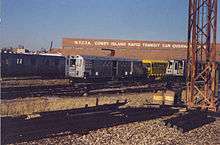
Most of the subway cars in the Transit Museum's fleet are operable, and they are frequently used for subway excursions run by the Museum and New York City Transit on various parts of the system. The subway cars are fully furnished with vintage advertising placards and route maps, completing the period atmosphere inside the vehicles. Tickets for Transit Museum excursions (called "Nostalgia Trains") are sold in advance. Some New York City Transit special trains (such as Holiday specials at the end of most years, and Yankee/Met specials) are available for anyone to ride, so long as they have paid the regular subway fare. In addition to the subway cars displayed in the Transit Museum, there are also a number of Museum cars that are kept off-site in various subway yards and shops while awaiting restoration, undergoing restoration, or in storage.
The following cars are displayed in the museum as of December 3, 2016:
- Track A1:
- R40 #4280-4281
- R16 #6387
- R38 #4028-4029
- BMT D-Type Triplex #6095A-B-C
- BRT AB Standard #2204
- R30 #8506
- R44 #5240
- Track A2
- BRT BU Gated El Cars #1404, 1273, 1407[24]
- R33 World's Fair #9306
- R12 #5760[24]
- R15 #6239[24]
- BMT Q-Type El Car #1612C[24]
- IRT Lo-V #4902
- Long Island Rail Road Caboose #C-60
- SBK Steeplecab #5
- R3 Pump Car #56
There are many cars not on display, but rather, are used on special fan excursions and other events. The rolling stock not on display include:
- SBK Steeplecab 6, 7
- IRT World's Fair Lo-V #5655
- BMT D-Type Triplex #6019A-B-C, 6112A-B-C
- R1 #100[24]
- R4 #484
- R7A #1575
- R10 #3189 (former Road Car Inspector School Training Car used at Pitkin Yard, 1984-2007)
- R11 #8013[24]
- R17 #6609 (used in the 1971 film The French Connection)[24]
- R26 #7774-7775
- R28 #7924-7925
- R29 #8678-8679
- R32 #3352-3353 (Rebuilt as Phase II)
- R33 #9010-9011, 9016-9017, 9068-9069, 9206-9207 (part of the Train of Many Colors excursion cars)
- R36 #9542-9543
- R36 WF #9586-9587
- R40A #4480-4481
- R42 #4572-4573 (used in the 1971 film The French Connection)
- R95 Revenue Collection Cars #0R714 (former R21 #7194) and #1R714 (former R22 #7422)
- "Money Train" Car #51050 (former R21 car #7203, modified and used in the 1995 film Money Train.)
Grand Central Gallery Annex and Store
The New York Transit Museum Gallery Annex and Store opened on September 14, 1993 at Grand Central Terminal, in the terminal's main concourse. It houses a transit-oriented gift shop as well as a space for rotating temporary exhibitions.[27] The Annex is the site of the Transit Museum's annual "Holiday Train Show," where an operating model train layout is displayed for the public. While there is an admission fee at the Transit Museum's main Brooklyn Heights location, entrance to the Annex is free.
The main Brooklyn Heights location also has its own gift shop, which is accessible outside of the Museum's paid area.
Gallery
- Classic wood-bodied "BU-type" elevated railcar, restored to original appearance and still operational
 BMT "Q-type" car, built in 1903 and updated in 1938; some were in revenue service for 66 years
BMT "Q-type" car, built in 1903 and updated in 1938; some were in revenue service for 66 years- Some Brooklyn Rapid Transit "AB Standard" steel-bodied cars remained in service for over 50 years
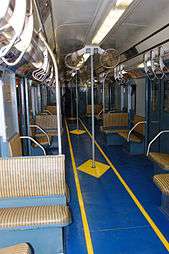 Interior of R7A car, a prototype for the R10 series
Interior of R7A car, a prototype for the R10 series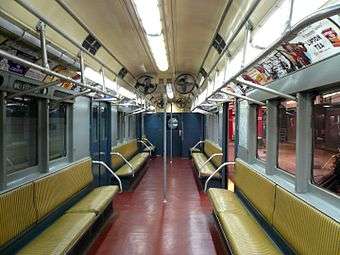 Interior of IRT R12 subway car with rattan seat cushions
Interior of IRT R12 subway car with rattan seat cushions- Exterior of an IRT "Lo-V" car
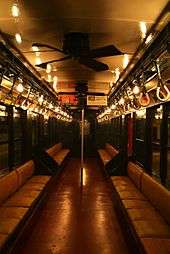 Interior of an IRT "Lo-V" car, with original advertising placards
Interior of an IRT "Lo-V" car, with original advertising placards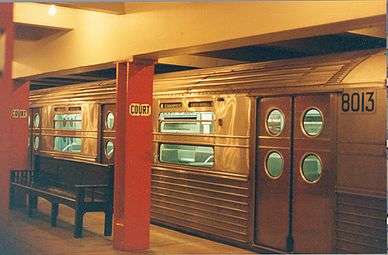 Exterior view of R11/R34, the first series built of stainless steel
Exterior view of R11/R34, the first series built of stainless steel- Interior of R34 car
- Vintage ad for Crisco on display inside a subway car
 An array of historic subway turnstiles
An array of historic subway turnstiles- A Diamond Jubilee subway token on display
- Machine used to sew bags of subway tokens
- Real "Money Train" car, retired circa 2006
 R33 #9206 on display at the museum in June 2016.
R33 #9206 on display at the museum in June 2016.
| Wikimedia Commons has media related to New York Transit Museum. |
See also
References
- 1 2 3 4 5 6 7 8 9 Plitt, Amy (June 28, 2011). "Highlights of the New York Transit Museum in New York City". Time Out. Retrieved September 12, 2016.
- 1 2 "Two Subway Links Start Wednesday". The New York Times. April 6, 1936. p. 23. Retrieved October 7, 2011.
- ↑ "NEW SUBWAY LINK OPENED BY MAYOR; He Tells 15,000 in Brooklyn It Will Be Extended to Queens When Red Tape Is Cut.". The New York Times. 1936-04-09. ISSN 0362-4331. Retrieved 2016-08-15.
- ↑ Egan, Leo (April 5, 1936). "Brooklyn's New $53,000,000 Subway Line Ready to Open Wednesday Night". Brooklyn Daily Eagle. p. 16. Retrieved 28 August 2016 – via Newspapers.com.
- 1 2 "IND Fulton Street Line". www.nycsubway.org. Retrieved 2016-02-18.
- ↑ Project for Expanded Rapid Transit Facilities, New York City Transit System, dated July 5, 1939
- ↑ Roger P. Roess; Gene Sansone (23 August 2012). The Wheels That Drove New York: A History of the New York City Transit System. Springer Science & Business Media. pp. 416–417. ISBN 978-3-642-30484-2.
- ↑ Jaffe, Alfred (December 6, 1946). "Borough Subway Relief Still 2 or 3 Years Off". Brooklyn Daily Eagle. pp. 1, 5. Retrieved 9 October 2015 – via Newspapers.com.
- ↑ Foley, A.J. (1946). "Sign for the Closing of the Court Street Station, 1946 ; IND Crosstown Line". New York Transit Museum. Retrieved 28 August 2016.
- ↑ Blauvelt, Paul (June 9, 1946). "Shortages Snarl $50,000,000 Tube Links". Brooklyn Daily Eagle. p. 21. Retrieved 9 October 2015 – via Newspapers.com.
- 1 2 Canby, Vincent (March 31, 1967). "Now, Subways are for Filming: T.A. Makes Old IND Court St. Station Available". The New York Times. Retrieved 27 August 2016.
- ↑ Taft, Lyman W. (October 13, 1954). "Finds Many Unused Subway Tunnels Under City Streets". Brooklyn Daily Eagle. p. 24. Retrieved 16 September 2015 – via Newspapers.com.
- ↑ Levey, Stanley (March 16, 1960). "New Cleaner Tested in Subway; Takes Off Dust (and Tiles, Too)". The New York Times. Retrieved 27 August 2016.
- ↑ "What a Difference A Week Made!" (PDF). Brooklyn Heights Press. Fultonhistory.com. July 19, 1962. p. 1. Retrieved 28 August 2016.
Entrance to abandoned Independent subway station at Court and Schermerhorn Sts. remains as dirty as ever, and still a favorite dumping ground for garbage.
- ↑ Weiler, A.H. (September 4, 1949). "Notes on the Film Scene". The New York Times. Retrieved 27 August 2016.
- ↑ Katz, Ralph (November 27, 1958). "Old Court Street Station Gets Role in Spy Film-as Bowling Green; Closed IND Station is Reopened For Day as Motion-Picture Set". The New York Times. Retrieved 27 August 2016.
- 1 2 3 4 5 "Old Train Will Come Here From Shut Station July 4" (PDF). Wave of Long Island. Fultonhistory.com. July 1, 1976. p. 6. Retrieved 22 July 2016.
- ↑ Burks, Edward C. (January 28, 1974). "It Looks Like Walter Matthau It Could Be Walter Matthau... It...". The New York Times. Retrieved 27 August 2016.
- 1 2 "Old Trains Run Weekends to Rockaway Park Station" (PDF). Wave of Long Island. Fultonhistory.com. July 22, 1976. p. 8. Retrieved 22 July 2016.
- ↑ "About NYC Transit - History". 2002-10-19. Retrieved 2016-09-18.
- ↑ "Transit Museum Becomes Accessible To Disabled". NY1. June 8, 2011. Retrieved June 25, 2011.
- ↑ "MTA - Transit Museum General Information". mta.info. Metropolitan Transportation Authority. Retrieved 2016-07-18.
- ↑ Avalith. "nytransitmuseum - Historypin". historypin.com.
- 1 2 3 4 5 6 7 8 9 10 11 12 13 14 15 16 17 "Vintage Fleet". New York Transit Museum. Retrieved 2016-09-12.
- 1 2 3 4 5 "MTA - Transit Museum General Information". mta.info.
- ↑ "ElectriCity". lsc.org.
- ↑ "New Yorkers & Co.". The New York Times. September 19, 1993. Retrieved September 22, 2009.
External links
|
Official websites Unofficial sites with official content |
Unofficial sites |
Google Maps Street View tours |
